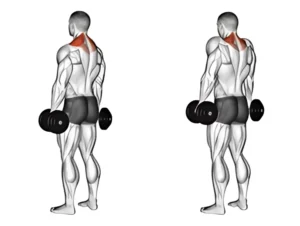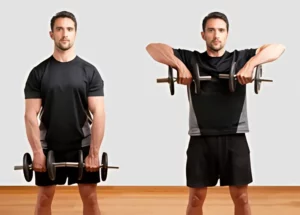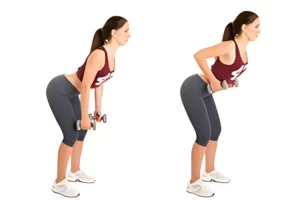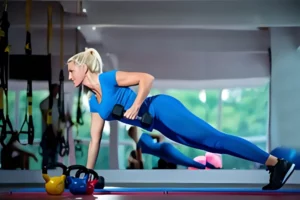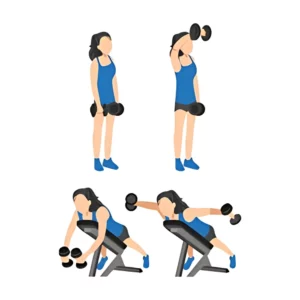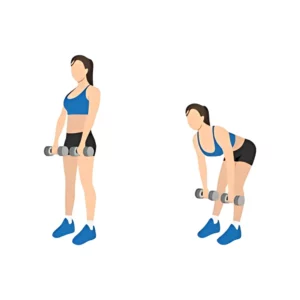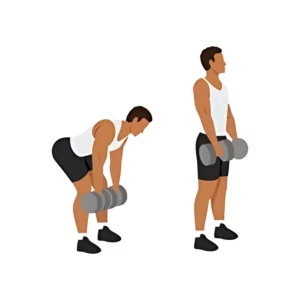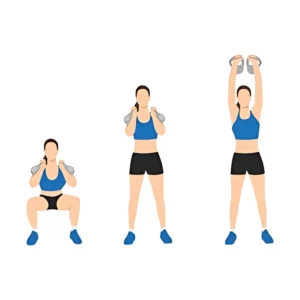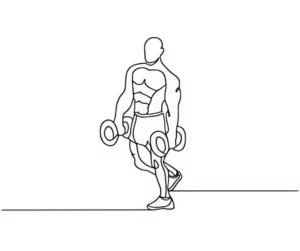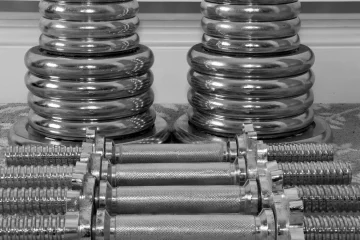As an Amazon Associate, I earn from qualifying purchases.
This article from the teamkathycarter website discusses the Best Trap Exercises Dumbbells and their benefits in detail. Let’s Start with a detailed explanation of trap exercises using dumbbells. Highlight the significance of traps in upper body strength and appearance. Mention that using dumbbells can offer many sides and effectiveness in targeting the traps.
What are Trap Exercises Dumbbells?
Define best trap exercises dumbbells and explain their significance in building strong, well-defined trapezius muscles. It means how dumbbells can be fulfilled for effective trap workouts.
Benefits of Trap Exercises Dumbbells?
Adding dumbbell trap exercises to your fitness routine has many benefits. These include increased muscle growth, better posture, and improved functional strength.
Table of Contents for Best Trap Exercises Dumbbells:
- Dumbbell Shrug
- Unilateral Dumbbell Shrug
- Dumbbell Upright Row
- Dumbbell High Pull
- Bent-Over Dumbbell Row
- Single-Arm Bent-Over Dumbbell Row
- Dumbbell Renegade Row
- The Dumbbell Reverse Flye
- Dumbbell Shrug Row
- The Dumbbell Deadlifts
- Dumbbell Clean and Press
- The Dumbbell Farmer’s Walk
- Dumbbell Shrug with Iso-Hold
13 Best Best Trap Exercises Dumbbells:
1. Dumbbell Shrug- Best Trap Exercises Dumbbells:
The dumbbell shrug is a great exercise that targets the trapezius muscles. This simple yet powerful movement can strengthen the upper traps and improve the shape and strength of the upper body.
Technique and Execution-
To perform a dumbbell shrug effectively:
- Start by standing straight with a dumbbell in each hand, arms fully extended by your sides.
- Keep a slight bend in your elbows.
- Engage your core for stability.
- Slowly elevate your shoulders toward your ears as high as possible, ensuring a controlled movement.
- Hold the contraction at the top for a brief moment, feeling the tension in your traps, and then slowly lower the dumbbells back down to the starting position.
Muscle Engagement:
The primary focus of the dumbbell shrug is on the upper trapezius muscles. This exercise targets the region between the neck and shoulders, aiding in developing strength and size in this area. Additionally, the movement engages the levator scapulae and rhomboid muscles to a lesser extent.
Variations and Tips:
While the standard dumbbell shrug involves a vertical movement, variations exist to add diversity to your routine. These include performing the shrugs seated or using a single arm at a time, allowing for better focus and isolation of each side. Additionally, altering the grip or using different hand placements can slightly change the emphasis on the traps.
Proper form is crucial to maximize the benefits of the dumbbell shrug. Ensure controlled movements throughout the exercise, avoiding jerking or swinging motions. Focus on a full range of motion, lifting the shoulders as high as possible while maintaining stability in the core and a neutral spine.
Benefits of Dumbbell Shrugs:
Incorporating dumbbell shrugs into your workout routine offers several advantages. When your traps are stronger, your shoulders are more stable. This helps you have better posture and reduces the risk of neck and shoulder discomfort. By developing well-defined traps, you can make your upper body look more sculpted.
Integration into Your Fitness Routine:
Dumbbell shrugs can be included in various workout routines, such as shoulder or upper body training days. They are effective as both a primary exercise for trap development and an accessory movement to complement other compound exercises like deadlifts or overhead presses.
2. Unilateral Dumbbell Shrug:
The Unilateral Dumbbell Shrug is a useful exercise that focuses on the trapezius muscles one at a time. This version of the dumbbell shrug isolates each side separately. It helps fix strength imbalances and promotes even trap development.
Execution Technique:
Initiating the Unilateral Dumbbell Shrug involves:
- Standing upright.
- Hold a dumbbell in one hand.
- Allowing another hand to remain free.
Start by elevating the shoulder on the working side towards the ear, focusing on a controlled movement. To have full motion, contract the traps at the top and slowly lower the dumbbell back. Perform the same movement on the opposite side.
Targeted Muscle Engagement:
This exercise primarily focuses on the upper trapezius muscles on each side of the neck and shoulders. To develop balanced muscles on both sides, engage each trap separately to overcome strength differences. This promotes functional symmetry.
Benefits of Unilateral Training:
The Unilateral Dumbbell Shrug goes beyond simply targeting the traps. Its emphasis on unilateral training provides several benefits, including enhanced balance and coordination. This method can find and fix muscle imbalances and weaknesses, lowering the chance of injury and improving overall strength.
Technique and Form Tips:
Maintaining proper posture throughout the exercise ensures the spine remains neutral and the core engaged. Avoid using momentum or excessive body movement to lift the dumbbell, focusing solely on the targeted muscle’s contraction.
Integration into Workout Regimens:
Including the Unilateral Dumbbell Shrug in your workout routine can be advantageous. It complements other unilateral exercises and offers a diversified approach to trap development. Utilize this exercise in dedicated shoulder workouts or as an accessory movement during upper-body training sessions.
Variations and Progression:
For added variety, experiment with different dumbbell weights and hand positions. Gradually increase resistance to challenge the traps further and stimulate muscle growth. Consider altering the tempo of the movement to introduce variations and maintain progress.
3. Dumbbell Upright Row- Best Trap Exercises Dumbbells:
The Dumbbell Upright Row is a compound exercise primarily targeting the deltoid muscles while engaging the traps and upper back. This exercise is renowned for its effectiveness in developing shoulder strength and definition.
Proper Execution Technique:
Begin by standing with a dumbbell in each hand, arms fully extended downward, and palms facing your body. Lift the dumbbells by pulling them straight up towards your chin, leading with your elbows, and keeping them higher than the wrists. Pause briefly at the top of the movement, then lower the dumbbells back down under control.
Muscle Engagement:
The primary focus of the Dumbbell Upright Row is on the lateral deltoids, responsible for the width and appearance of the shoulders. Additionally, the exercise engages the traps, especially the upper fibres, and the upper back muscles to assist in the pulling motion.
Benefits of Dumbbell Upright Rows:
Incorporating this exercise into your routine can yield various benefits. It aids in developing broader shoulders, enhancing upper body aesthetics. Strengthening the deltoids can also improve shoulder stability, benefiting multiple other upper-body movements and reducing the risk of injury.
Technique and Form Tips:
Maintaining proper form is crucial to maximize the benefits of this exercise and prevent potential shoulder strain. Focus on a controlled movement throughout the training, avoiding excessive swinging or using momentum. Ensure the elbows remain higher than the wrists to engage the targeted muscles effectively.
Precautions and Modifications:
Individuals with pre-existing shoulder issues or discomfort might find the upright row motion uncomfortable. In such cases, modifying the exercise by using lighter weights, altering hand positioning, or substituting with alternative exercises like lateral raises can reduce strain on the shoulders while effectively targeting the deltoids.
Integration into Workout Routines:
The Dumbbell Upright Row can be incorporated into shoulder-focused workouts or upper-body training sessions. It serves as a valuable addition, complementing other shoulder exercises, such as overhead presses or lateral raises, to target different areas of the deltoids.
Variations and Progression:
Experimenting with variations, such as using different grips or incorporating pauses at the top of the movement, can add diversity to your routine and stimulate muscle growth. Gradually increasing the weight as strength improves allows progressive overload and continued development.
4. Dumbbell High Pull:
The Dumbbell High Pull is a dynamic compound exercise known for its effectiveness in developing strength and power in the shoulders, traps, and upper back. This exercise combines elements of both a deadlift and an upright row, making it a versatile addition to any strength training routine.
Execution Technique:
Begin standing with a dumbbell in each hand, palms facing your thighs. Engage your core and initiate the movement by bending your knees and hinging at the hips to lower the dumbbells toward the ground. Explosively extend your hips and knees while pulling the dumbbells upward, leading with your elbows to bring them towards your shoulders. Lower the dumbbells back down under control.
Muscle Engagement:
The primary focus of the Dumbbell High Pull is on the shoulders, specifically the deltoids, which are responsible for shoulder strength and stability. Additionally, this exercise engages the traps, upper back, and core to stabilize the body throughout the movement.
Benefits of Dumbbell High Pulls:
Incorporating the Dumbbell High Pull into your workout routine offers numerous advantages. It enhances explosive power in the shoulders and upper body, making it beneficial for athletes involved in sports requiring strength and speed. Furthermore, the exercise promotes muscle growth and definition in the shoulders and traps.
Technique and Form Tips:
Maintaining proper form is crucial to perform the Dumbbell High Pull safely and effectively. Focus on generating power from the lower body while maintaining a solid core and keeping the back straight throughout the movement. Ensure that the dumbbells follow a straight path as you pull them towards your shoulders.
Precautions and Modifications:
Individuals with pre-existing shoulder or lower back issues should exercise caution or consider alternative exercises that put less strain on these areas. Additionally, starting with lighter weights and gradually increasing the load can help master the movement and prevent potential injuries.
Integration into Workout Routines:
The Dumbbell High Pull can be integrated into strength training routines, particularly those focusing on power and explosive movements. It can be utilized as part of a full-body workout or upper-body training sessions to effectively target the shoulders, traps, and upper back.
Variations and Progression:
Experimenting with variations, such as altering grip width or adjusting the speed of the movement, can add variety and challenge your muscles differently. Gradually increasing the weight as strength improves allows for progressive overload, leading to continued gains in strength and power.
5. Bent-Over Dumbbell Row:
The Bent-Over Dumbbell Row is a foundational exercise renowned for its effectiveness in targeting the back muscles, particularly the lats, rhomboids, and traps. This compound movement contributes significantly to back strength, muscle development, and overall upper-body stability.
Execution Technique:
To begin, stand with your feet shoulder-width apart while holding a dumbbell in each hand. Hinge forward at the hips, keeping the back straight and chest up. Let the dumbbells hang beneath the shoulders. Pull the dumbbells towards your sides, retract the shoulder blades, and squeeze the back muscles. Lower the dumbbells down with complete control and confidence, ensuring a smooth return to the starting position.
Muscle Engagement:
The Bent-Over Dumbbell Row primarily targets the latissimus dorsi, the large muscles spanning the mid to lower back. Additionally, this exercise engages the rhomboids, traps, rear delts, and even the biceps, offering a comprehensive upper-body workout.
Benefits of Bent-Over Dumbbell Rows:
Incorporating this exercise into your routine offers a multitude of benefits. It aids in developing a strong and well-defined back, improving posture, and enhancing overall upper body strength. The engagement of various muscle groups contributes to a balanced and sculpted physique.
Technique and Form Tips:
It is crucial to maintain proper form throughout the exercise. Focus on keeping the spine neutral, avoiding back rounding, and engaging the core for stability. Ensure a controlled movement, pulling the dumbbells towards the hips while retracting the shoulder blades for maximal muscle contraction.
Precautions and Modifications:
Individuals with lower back issues or limited mobility might find the bent-over position challenging. In such cases, modifying the exercise by using a bench for support or opting for a chest-supported dumbbell row can alleviate strain on the lower back while still effectively targeting the back muscles.
Integration into Workout Routines:
The Bent-Over Dumbbell Row can be a cornerstone of back-focused workouts or integrated into full-body or upper-body training sessions. It complements other compound exercises like pull-ups or deadlifts, offering a well-rounded approach to back development.
Variations and Progression:
Experiment with variations such as using different grips, altering the angle of the torso, or incorporating pauses at the top of the movement to challenge your back muscles differently. Gradually increasing weight as strength improves allows progressive overload and continued muscle growth.
6. Single-Arm Bent-Over Dumbbell Row
The Single-Arm Bent-Over Dumbbell Row is a unilateral exercise renowned for targeting and developing the back muscles, offering an opportunity to address strength imbalances and promote symmetry in muscle development.
Execution Technique:
Start by placing one hand and knee on a bench, keeping the back flat and parallel to the ground. With a dumbbell in the free hand, allow it to hang straight down. Pull the dumbbell towards the hip, retracting the shoulder blade and maintaining a controlled movement. Lower the dumbbell back down, ensuring a full range of motion.
Muscle Engagement:
This exercise targets the lats, rhomboids, and traps on one side of the back. Isolating each side independently promotes balanced muscle development, rectifies strength discrepancies, and enhances overall back strength.
Benefits of Single-Arm Bent-Over Rows:
Incorporating this exercise into your routine offers several advantages. It aids in building a solid and symmetrical back, improves muscular balance, and helps address any weaknesses or imbalances between the left and right sides.
Technique and Form Tips:
Maintaining proper form is essential for maximizing the benefits of this exercise. Focus on keeping the back flat and the core engaged throughout the movement. Ensure controlled and deliberate actions, pulling the dumbbell towards the hip while maintaining stability.
Precautions and Modifications:
Individuals with lower back issues or difficulties maintaining balance might find this exercise challenging. Initially, Using a lighter weight or seeking support by placing the non-working hand on a bench can help alleviate strain and maintain proper form.
Integration into Workout Routines:
The Single-Arm Bent-Over Dumbbell Row can be integrated into back-focused workouts or incorporated as an accessory movement during upper-body training sessions. It complements other unilateral exercises and contributes to a well-rounded back routine.
Variations and Progression:
Experiment with variations such as altering hand positions or inclining the bench to challenge the back muscles differently. Gradually increasing weight or focusing on higher reps with proper form allows continued progression and muscle growth.
7. Dumbbell Renegade Row:
The Dumbbell Renegade Row stands as a challenging and dynamic exercise renowned for its effectiveness in targeting not just the back muscles but also engaging the core and stabilizing muscles. This compound movement offers a comprehensive workout for multiple muscle groups simultaneously.
Execution Technique:
Start in a plank position, with each hand gripping a dumbbell. Keep the body in a straight line from head to heels, engaging the core for stability. Alternately, row one dumbbell towards the hip while stabilizing the body with the other arm. Maintain a controlled movement and avoid rotating the hips—alternate sides for repetitions.
Muscle Engagement:
The Dumbbell Renegade Row primarily targets the back muscles, including the latissimus dorsi, rhomboids, and traps, while engaging the stabilizer muscles in the core, shoulders, and arms. This exercise emphasizes full-body stability and strength.
Benefits of Dumbbell Renegade Rows:
Incorporating this exercise into your routine offers numerous advantages. It not only strengthens the back muscles for improved posture and upper body strength but also engages the core intensely, aiding in core stability and development.
Technique and Form Tips:
Maintaining proper form throughout the exercise is essential for maximizing benefits and preventing injury. Focus on stabilizing the body and preventing excessive rotation by engaging the core. Avoid rocking or swaying the hips, and ensure controlled movements during the rowing motion.
Precautions and Modifications:
Individuals with wrist issues or difficulty stabilizing in a plank position might find this exercise challenging. Starting with lighter weights or using a modified plank position, such as kneeling on the floor, can help master the movement and gradually progress to the complete Renegade Row.
Integration into Workout Routines:
The Dumbbell Renegade Row can be incorporated into full-body workouts or upper-body training sessions. It is an effective compound exercise that challenges both the back muscles and the core, contributing to a balanced and functional physique.
Variations and Progression:
Experimenting with variations such as altering hand positions or incorporating pauses at the top of the row can add variety and challenge the muscles differently. Gradually increasing weight or focusing on higher reps with proper form allows continued progression and muscle growth.
8. Dumbbell Reverse Flye- Best Trap Exercises Dumbbells:
The Dumbbell Reverse Flye stands as a powerful exercise known for its ability to target the rear deltoids, upper back muscles, and shoulder stabilizers. This isolation movement enhances shoulder strength, posture, and overall upper body aesthetics.
Execution Technique:
Start by standing with a dumbbell in each hand, palms facing each other. Slightly bend your knees, hinge at the hips, and lean forward, keeping your back straight. Lift the dumbbells out to the sides in an arc motion, leading with the elbows until they reach shoulder height. Focus on squeezing the shoulder blades together and maintaining a controlled movement.
Muscle Engagement:
The primary focus of the Dumbbell Reverse Flye is on the rear deltoids, which are essential for shoulder stability and rounded shoulder aesthetics. Additionally, this exercise engages the upper back muscles, including the rhomboids and traps, aiding in better posture and upper body strength.
Benefits of Dumbbell Reverse Flyes:
Incorporating this exercise into your routine offers several benefits. It targets the often-neglected rear deltoids, contributing to balanced shoulder development and reducing the risk of shoulder imbalances. Strengthening the upper back muscles helps improve posture and reduce the likelihood of shoulder injuries.
Technique and Form Tips:
Maintaining proper form throughout the exercise is crucial for maximizing benefits and preventing injury. Focus on a controlled movement, avoiding momentum and excessive swinging. Ensure a slight bend in the elbows and maintain a neutral spine position throughout the action.
Precautions and Modifications:
Individuals with shoulder issues or limited shoulder mobility might find this exercise challenging. Starting with lighter weights, gradually increasing resistance, or modifying the range of motion can help master the movement and avoid strain on the shoulders.
Integration into Workout Routines:
The Dumbbell Reverse Flye can be integrated into shoulder-focused or upper-body training sessions. It serves as an excellent complementary exercise to movements that primarily target the front delts, providing a well-rounded approach to shoulder development.
Variations and Progression:
Experiment with variations such as adjusting the angle of the torso or using different hand positions to challenge the muscles differently. Gradually increasing weight or focusing on higher reps with proper form allows progressive overload and continued muscle growth.
9. Dumbbell Shrug Row:
The Dumbbell Shrug Row combines the benefits of a traditional shrug and a rowing motion, targeting the upper back muscles, traps, and rear delts. This compound exercise effectively strengthens and defines the upper back while engaging multiple muscle groups simultaneously.
Execution Technique- Best Trap Exercises Dumbbells:
Start by holding a dumbbell in each hand, palms facing your body. Hinge forward at the hips, keeping the back straight and the core engaged. Perform a shrug by elevating your shoulders toward the ears, followed by a rowing motion, pulling the dumbbells towards your sides while retracting the shoulder blades. Lower the dumbbells back down in a controlled manner.
Muscle Engagement:
The Dumbbell Shrug Row primarily targets the upper back muscles, including the traps, rhomboids, and rear delts. This exercise emphasizes both the shrugging and rowing motions, effectively engaging the targeted muscle groups for improved strength and definition.
Benefits of Dumbbell Shrug Rows:
Incorporating this exercise into your routine offers several benefits. It helps develop a solid and well-defined upper back, enhances posture, and reduces the risk of shoulder and neck discomfort. Strengthening the traps and rear delts contributes to a more balanced and sculpted upper body.
Technique and Form Tips:
Maintaining proper form is crucial for maximizing the benefits and preventing injury. Focus on a controlled movement throughout the exercise, avoiding jerking or using momentum. Ensure a full range of motion by lifting the shoulders towards the ears and retracting the shoulder blades during the rowing motion.
Precautions and Modifications:
Individuals with pre-existing shoulder issues or limited shoulder mobility might find this exercise challenging. Starting with lighter weights or reducing the range of motion can help master the movement while minimizing strain on the shoulders.
Integration into Workout Routines:
The Dumbbell Shrug Row can be integrated into back-focused workouts or upper-body training sessions. It complements other back exercises and serves as an effective movement to target the traps and rear delts for a comprehensive upper back workout.
Variations and Progression:
Experiment with variations, such as using different hand placements or altering the grip to challenge the muscles differently. Gradually increasing weight or focusing on higher reps with proper form allows for continued progression and muscle growth.
10. Dumbbell Deadlifts:
Dumbbell Deadlifts stand as a foundational exercise renowned for their ability to engage multiple muscle groups, emphasizing strength, stability, and functional movement patterns. This compound exercise offers a versatile and effective way to target various muscle groups simultaneously.
Execution Technique- Best Trap Exercises Dumbbells:
Begin by standing with your feet shoulder-width apart, holding a dumbbell in each hand, palms facing your thighs—hinge at the hips, maintaining a neutral spine and slight knee bend. Lower the dumbbells towards the ground while keeping them close to your body. Drive through the heels and stand tall, engaging the glutes and core at the movement’s top.
Muscle Engagement- Best Trap Exercises Dumbbells:
The primary focus of Dumbbell Deadlifts is on the posterior chain, engaging muscles such as the hamstrings, glutes, lower back, and spinal erectors. This exercise recruits the core muscles, forearms, and traps to stabilize the body throughout the movement.
Benefits of Dumbbell Deadlifts:
Incorporating this exercise into your routine offers numerous advantages. It builds strength in the lower body while improving hip mobility and overall posture. The engagement of multiple muscle groups simultaneously makes it an efficient exercise for full-body strength development.
Technique and Form Tips:
Maintaining proper form is crucial for maximizing benefits and preventing injury. Focus on keeping the spine neutral and the chest lifted throughout the movement. Ensure a controlled descent and ascent, avoiding rounding of the back or using excessive momentum.
Precautions and Modifications:
Individuals with back issues or limited mobility should approach this exercise cautiously. Starting with lighter weights, focusing on proper form, or consulting a fitness professional for guidance can help you master the movement safely.
Integration into Workout Routines:
Dumbbell Deadlifts can be incorporated into various workout routines, including full-body workouts and lower-body training sessions, or as a compound movement in strength training programs. They serve as an effective foundational exercise for developing overall strength and stability.
Variations and Progression:
Experiment with variations such as single-leg deadlifts or deficit deadlifts to challenge different muscle groups and movement patterns. Gradually increasing weight or focusing on higher reps with proper form allows for progressive overload and continued strength gains.
11. Dumbbell Clean and Press:
The Dumbbell Clean and Press is a dynamic and compound exercise renowned for its ability to engage multiple muscle groups. It emphasizes full-body strength, power, and coordination. This movement integrates clean and press elements, offering a challenging yet effective workout.
Execution Technique:
Start in a standing position, holding a dumbbell in each hand by your sides. Initiate the movement by performing a clean, lifting the dumbbells explosively to shoulder height by extending the hips and knees. Once in the racked position, press the dumbbells overhead, fully extending the arms. Lower the dumbbells back down in a controlled manner to complete the repetition.
Muscle Engagement:
The Dumbbell Clean and Press targets various muscle groups simultaneously. The clean engages the lower body, including the quadriceps, hamstrings, glutes, and calves, while the press primarily targets the shoulders, triceps, and core muscles to stabilize the movement.
Benefits of Dumbbell Clean and Press:
Incorporating this exercise into your routine offers several benefits. It promotes full-body strength and power, improves explosive strength and coordination, and enhances shoulder stability and mobility. This compound movement challenges multiple muscle groups, making it an efficient addition to strength training regimens.
Technique and Form Tips:
Maintaining proper form is essential for maximizing benefits and preventing injury. Focus on generating power from the lower body during the clean, keeping the back straight and core engaged. During the press phase, ensure a stable base and avoid overarching the lower back.
Precautions and Modifications:
Individuals with shoulder or lower back issues should approach this exercise cautiously. Starting with lighter weights, focusing on mastering the technique, or seeking guidance from a fitness professional can help you perform the movement safely and effectively.
Integration into Workout Routines:
The Dumbbell Clean and Press can be incorporated into full-body workouts or upper-body training sessions. It is an excellent compound movement for developing strength, power, and coordination, which contribute to overall athletic performance.
Variations and Progression:
Experiment with variations such as alternating arms, using different grips, or adjusting the tempo to challenge the muscles differently. Gradually increasing weight or focusing on performing more reps with proper form allows for progressive overload and continued strength gains.
12. Dumbbell Farmer’s Walk:
The Dumbbell Farmer’s Walk, a fundamental yet practical exercise, involves walking while holding dumbbells by your sides. It’s a dynamic and versatile movement that primarily targets grip strength, core stability, and overall muscular endurance, offering a range of benefits for fitness enthusiasts of all levels.
Execution Technique:
Start by standing tall with a dumbbell in each hand, maintaining a neutral spine and engaged core. Walk a predetermined distance while holding the dumbbells firmly at your sides, focusing on an upright posture and avoiding excessive swaying or leaning. Maintain a controlled pace throughout the walk.
Muscle Engagement:
The Dumbbell Farmer’s Walk primarily focuses on the muscles that contribute to grip strength, including the forearms, wrists, and hands. Additionally, this exercise engages the muscles of the upper back, shoulders, core, and even the lower body for overall stability and coordination.
Benefits of Dumbbell Farmer’s Walk:
Incorporating this exercise into your routine offers numerous benefits. It significantly improves grip strength, leading to better performance in various lifting exercises. Furthermore, it engages the core and stabilizer muscles, enhancing overall functional strength and endurance.
Technique and Form Tips:
Maintaining proper form throughout the exercise is essential for maximizing benefits and preventing injury. Focus on pulling the shoulders back and down, lifting the chest, and walking with a natural stride. Ensure a firm grip on the dumbbells without excessively tensing the arms.
Precautions and Modifications:
Individuals with existing hand or wrist injuries should approach this exercise cautiously. Starting with lighter weights and gradually increasing resistance or consulting a fitness professional for modifications can help perform the exercise safely.
Integration into Workout Routines:
The Dumbbell Farmer’s Walk can be incorporated into various workout routines, including full-body workouts and strength training sessions, or as a finisher to test endurance. It serves as a functional exercise that translates well into everyday activities requiring grip strength and stability.
Variations and Progression:
Experiment with variations such as uneven loads, walking on different surfaces, or incorporating turns during the walk to challenge stability and coordination. Gradually increasing weight or duration of the walk allows for progressive overload and continued strength gains.
13. Dumbbell Shrug with Iso-Hold:
The Dumbbell Shrug with Iso-Hold is an advanced variation of the traditional shrug exercise. It accentuates trap muscle engagement and endurance. This exercise incorporates an isometric hold at the top of the movement, intensifying the muscle contraction and promoting more significant strength gains.
Execution Technique:
Start by holding a dumbbell in each hand by your sides, palms facing inward. Elevate your shoulders as you would in a standard shrug. However, pause and hold the contracted position at the top of the movement for a designated period, typically 3-5 seconds, emphasizing the squeeze on the traps. Lower the dumbbells back down in a controlled manner and repeat.
Muscle Engagement:
The primary focus of the Dumbbell Shrug with Iso-Hold is on the trapezius muscles. The isometric hold at the top of the movement maximizes the time under tension on the traps, promoting greater muscle activation and endurance.
Benefits of Dumbbell Shrug with Iso-Hold:
Incorporating this exercise into your routine offers several advantages. It effectively targets the traps, aiding in building strength, size, and endurance in these muscles. The isometric hold enhances the mind-muscle connection and fosters better muscle control and engagement.
Technique and Form Tips:
Maintaining proper form is crucial for maximizing benefits and preventing injury. Focus on elevating the shoulders while keeping the arms straight and maintaining a neutral spine. Consciously squeeze and contract the traps as intensely as possible during the isometric hold.
Precautions and Modifications:
Individuals with neck or shoulder issues should approach this exercise cautiously. Starting with lighter weights, focusing on mastering the technique, or consulting a fitness professional for guidance can help you perform the movement safely and effectively.
Integration into Workout Routines:
The Dumbbell Shrug with Iso-Hold can be incorporated into back-focused workouts or shoulder training sessions. It serves as a valuable addition to targeting the traps specifically and complements other trap-focused exercises in a comprehensive upper-body workout routine.
Variations and Progression:
Experiment with variations such as altering grip width or using different implements like kettlebells to challenge the traps differently. Gradually increasing the hold duration or weight allows progressive overload and continued trap muscle development.
Last word about the Best Trap Exercises Dumbbells
Recap the key points covered in the article, emphasizing the effectiveness and versatility of using Best Trap Exercises Dumbbells. Encourage readers to incorporate these exercises into their fitness routine for better trap development.
As an Amazon Associate, I earn from qualifying purchases.


